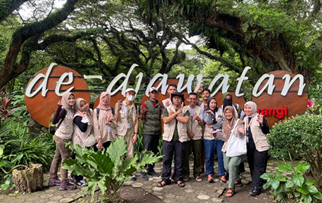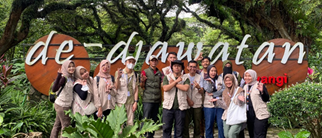
Twenty Three students of the Environmental Management Master Program (MPL) Graduate School of Gadjah Mada University carried out structured Field Work Lecture (KKL) activities in the Banyuwangi Regency area. Accompanied by Dr. Langgeng Wahyu Santosa, S.Si., M.Si., as Chief of Environmental Management Master Program and KKL coordinator, this activity took place on January 21st 2025.
This activity is a series of KKL carried out in Banyuwangi Regency and students are divided into 2 (two) groups. Group A visited the Ijen Crater Geoforest and sulfur processing, TPI Muncar, Jangir Waterfall, and TPS3R Bio Mandiri Lestari.
The students dived straight in and studied the potential of the Ijen Crater Caldera with a diameter of 200 m, the use of sulfur and blue fire as a tourist feature, located at an altitude of 2,386 meters. Based on field results, Jagir Waterfall is used by local residents as raw water and ecotourism.
“Thanks God, the implementation of the Field Work Lecture in Banyuwangi Regency went smoothly and provided great benefits for students in increasing their insight and direct experience in the field. We would like to thank the Environmental Management Master Program lecturers and the Banyuwangi Regency Environmental Service who have helped and accompanied this activity so that it can run well. “Hopefully the results of this Field Work Lecture can make a positive contribution to the progress of Banyuwangi Regency, especially in better and sustainable environmental management,” said Bramantio Dzaki, one of the MPL students who participated in the KKL activities.
Students also visited the Reduce-Reuse-Recycle (TPS3R) Waste Processing Site with waste problems in coastal and residential areas. This TPS3R is located on a plain with a topography of 0-3%, is in a public area (Suropati Park – community activity center) with a capacity of 20 tonnes/ day and serves 4 villages. The last visit was to TPA Muncar and the problem was the disposal of waste from TPA and domestic activities into the sea. The coastal area saw piles of rubbish. The beach at TPA Muncar is a sandy beach with a gentle slope with a beach length of ± 13 km and a fish landing of 4.5 km.
Meanwhile, group B visited the Kedungwungu (dragon fruit) plantation, Pang-Pang Bay Mangrove and Pond, and De Djawatan. The visit made to Pang-Pang Bay is a mangrove marine tourism destination which happens to be located close to shrimp ponds. Based on observations in the field, the shrimp ponds dump waste directly into the estuary. The last location visited by group B was De Djawatan which has its own attraction and is visited by tourists who come to Banyuwangi Regency.
Author: Siti Muyasaroh


